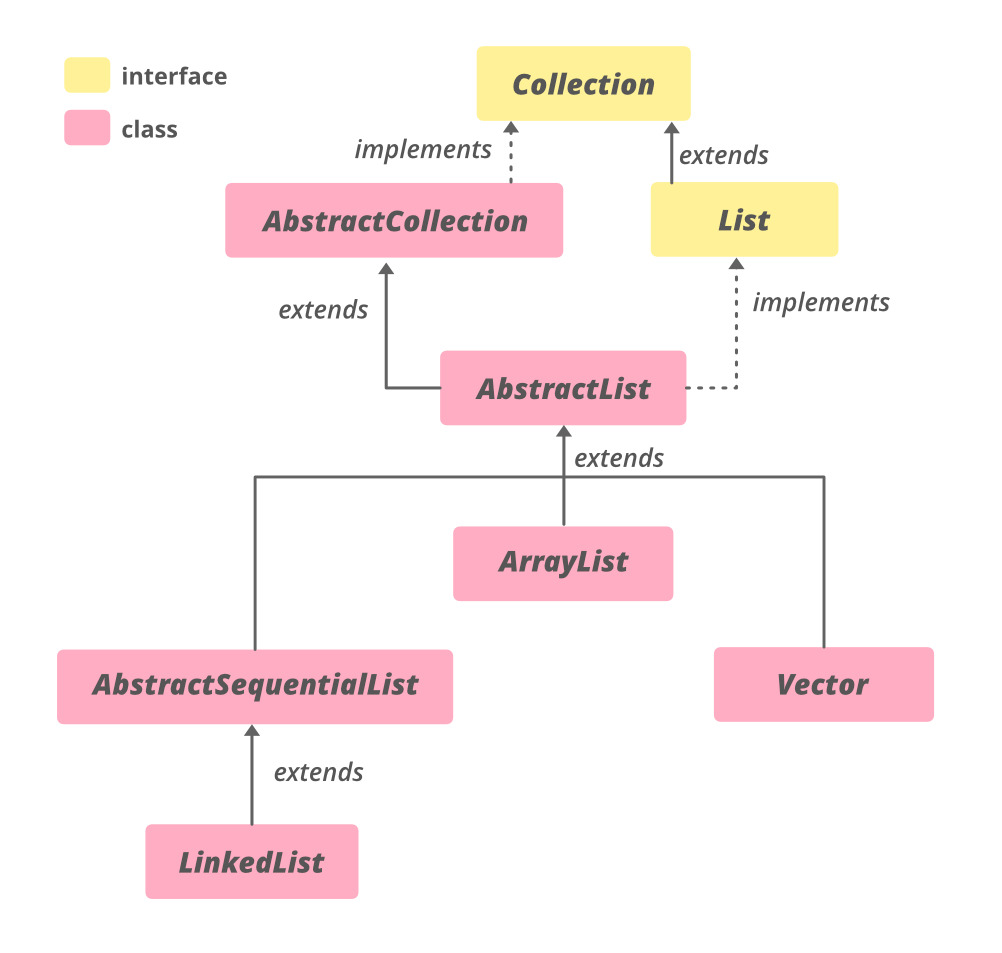AbstractSequentialListJava 中的类是Java集合框架并实施采集接口和AbstractCollection 类。它用于实现一个不可修改的列表,只需扩展AbstractList类并仅实现get()和size()方法。
此类提供 List 接口的骨架实现,以最大限度地减少实现由 “sequential access” 数据存储(例如链接列表)支持的接口所需的工作量。对于随机访问数据(例如数组),应优先使用AbstractList而不是此类。
类层次结构:

声明:
public abstract class AbstractSequentialList<E>
extends AbstractList<E>
Where E is the type of element maintained by this List.
它实现了可迭代<E>,集合<E>,List Interface接口。LinkedList是 AbstractSequentialList 的唯一直接子类。
构造函数:受保护AbstractSequentialList()-默认构造函数,但受保护,不允许创建 AbstractSequentialList 对象。
AbstractSequentialList<E> asl = new LinkedList<E>();
示例 1:AbstractSequentialList 是一个抽象类,因此应该为其分配一个子类的实例,例如LinkedList.
Java
// Java code to illustrate AbstractSequentialList
import java.util.*;
public class GfG {
public static void main(String[] args)
{
// Creating an instance of
// the AbstractSequentialList
AbstractSequentialList<Integer> absl
= new LinkedList<>();
// adding elements to absl
absl.add(5);
absl.add(6);
absl.add(7);
// Printing the list
System.out.println(absl);
}
}[5, 6, 7]
输出:
[5, 6, 7]
示例2:
Java
// Java code to illustrate
// methods of AbstractSequentialList
import java.util.*;
import java.util.AbstractSequentialList;
public class AbstractSequentialListDemo {
public static void main(String args[])
{
// Creating an empty AbstractSequentialList
AbstractSequentialList<String>
absqlist = new LinkedList<String>();
// Using add() method to
// add elements in the list
absqlist.add("Geeks");
absqlist.add("for");
absqlist.add("Geeks");
absqlist.add("10");
absqlist.add("20");
// Output the list
System.out.println("AbstractSequentialList: "
+ absqlist);
// Remove the head using remove()
absqlist.remove(3);
// Print the final list
System.out.println("Final List: "
+ absqlist);
// Fetching the specific
// element from the list
// using get() method
System.out.println("The element is: "
+ absqlist.get(2));
}
}AbstractSequentialList: [Geeks, for, Geeks, 10, 20] Final List: [Geeks, for, Geeks, 20] The element is: Geeks
输出:
AbstractSequentialList: [Geeks, for, Geeks, 10, 20] Final List: [Geeks, for, Geeks, 20] The element is: Geeks
Methods of AbstractSequentialList
|
METHOD |
DESCRIPTION |
|---|---|
| AbstractSequentialList add() | 在此列表中的指定位置插入指定元素(可选操作)。 |
| AbstractSequentialList addAll() | 将指定集合中的所有元素插入到此列表的指定位置(可选操作)。 |
| 获取(整数索引) | 返回此列表中指定位置的元素。 |
| AbstractSequentialList iterator() | 返回此列表中元素的迭代器(按正确的顺序)。 |
| AbstractSequentialList ListIterator() | 返回此列表中元素的列表迭代器(按正确的顺序)。 |
| AbstractSequentialList remove() | 删除此列表中指定位置的元素(可选操作)。 |
| AbstractSequentialList set() | 将此列表中指定位置的元素替换为指定元素(可选操作)。 |
Methods Inherited From class java.util.AbstractList
|
METHOD |
DESCRIPTION |
|---|---|
| AbstractList add(E ele) | 将指定元素追加到此列表的末尾(可选操作)。 |
| AbstractList clear() | 从此列表中删除所有元素(可选操作)。 |
| AbstractList equals() | 比较指定对象与此列表是否相等。 |
| AbstractList hashCode() | 返回此列表的哈希码值。 |
| AbstractList indexOf() | 返回此列表中指定元素第一次出现的索引,如果此列表不包含该元素,则返回 -1。 |
| AbstractList lastIndexOf() | 返回此列表中最后一次出现的指定元素的索引,如果此列表不包含该元素,则返回 -1。 |
| AbstractList listIterator() | 返回此列表中元素的列表迭代器(按正确的顺序)。 |
| removeRange(int fromIndex, int toIndex) | 从此列表中删除索引介于 fromIndex(包含)和 toIndex(不包含)之间的所有元素。 |
| AbstractList subList() | 返回此列表中指定的 fromIndex(包含)和 toIndex(不包含)之间的部分的视图。 |
从类 java.util.AbstractCollection 继承的方法
|
METHOD |
DESCRIPTION |
|---|---|
| AbstractCollection addAll() | 将指定集合中的所有元素添加到此集合中(可选操作)。 |
| AbstractCollection contains() | 如果此集合包含指定元素,则返回 true。 |
| AbstractCollection containsAll() | 如果此集合包含指定集合中的所有元素,则返回 true。 |
| AbstractCollection isEmpty() | 如果此集合不包含任何元素,则返回 true。 |
| AbstractCollection remove() | 从此集合中删除指定元素的单个实例(如果存在)(可选操作)。 |
| AbstractCollection removeAll() | 删除指定集合中也包含的所有该集合的元素(可选操作)。 |
| AbstractCollection retainAll() | 仅保留此集合中包含在指定集合中的元素(可选操作)。 |
| AbstractCollection toArray() | 返回一个包含此集合中所有元素的数组。 |
| AbstractCollection toArray() | 返回一个包含该集合中所有元素的数组;返回数组的运行时类型是指定数组的运行时类型。 |
| AbstractCollection toString() | 返回此集合的字符串表示形式。 |
Methods Inherited From Interface java.util.Collection
|
METHOD |
DESCRIPTION |
|---|---|
| parallelStream() | 返回一个可能并行的 Stream 并以此集合作为其源。 |
| removeIf(Predicate<? super E> 过滤器) | 删除此集合中满足给定谓词的所有元素。 |
| stream() | 返回以此集合作为源的顺序 Stream。 |
| toArray(IntFunction<T[]> 生成器) | 返回一个包含此集合中所有元素的数组,使用提供的生成器函数分配返回的数组。 |
Methods Inherited From Interface java.lang.Iterable
|
METHOD |
DESCRIPTION |
|---|---|
| forEach(消费者<? super T> 操作) | 对 Iterable 的每个元素执行给定的操作,直到处理完所有元素或该操作引发异常。 |
Methods Inherited From Interface java.util.List
| METHOD | DESCRIPTION |
|---|---|
| List addAll() |
将指定集合中的所有元素按它们所在的顺序附加到此列表的末尾 由指定集合的迭代器返回(可选操作)。 |
| List contains() | 如果此列表包含指定元素,则返回 true。 |
| List containsAll() | 如果此列表包含指定集合的所有元素,则返回 true。 |
| List isEmpty() | 如果此列表不包含任何元素,则返回 true。 |
| remove(Object o) | 从此列表中删除第一次出现的指定元素(如果存在)(可选操作)。 |
| List removeAll() | 从此列表中删除指定集合中包含的所有元素(可选操作)。 |
| ReplaceAll(UnaryOperator<E> 运算符) | 将此列表中的每个元素替换为将运算符应用于该元素的结果。 |
| List retainAll() | 仅保留此列表中指定集合中包含的元素(可选操作)。 |
| List size() | 返回此列表中的元素数量。 |
| 排序(比较器<? super E> c) | 根据指定比较器产生的顺序对此列表进行排序。 |
| spliterator() | 在此列表中的元素上创建一个 Spliterator。 |
| toArray() | 返回一个数组,其中按正确顺序(从第一个元素到最后一个元素)包含此列表中的所有元素。 |
| toArray(T[] a) |
返回一个数组,其中按正确顺序(从第一个元素到最后一个元素)包含此列表中的所有元素; 返回数组的运行时类型是指定数组的运行时类型。 |
Java 中的 AbstractSequentialList 类是 AbstractList 的子类,它提供 List 接口的骨架实现,特别适用于允许顺序访问其元素的列表。这意味着可以按可预测的顺序访问元素,例如从第一个到最后一个。
以下是如何在 Java 中使用 AbstractSequentialList 类的示例:
Java
import java.util.AbstractSequentialList;
import java.util.List;
import java.util.ListIterator;
public class MyList extends AbstractSequentialList<Integer> {
private int size;
public MyList(int size) {
this.size = size;
}
@Override
public ListIterator<Integer> listIterator(int index) {
return new ListIterator<Integer>() {
private int currentIndex = index;
@Override
public boolean hasNext() {
return currentIndex < size;
}
@Override
public Integer next() {
return currentIndex++;
}
@Override
public boolean hasPrevious() {
return currentIndex > 0;
}
@Override
public Integer previous() {
return currentIndex--;
}
@Override
public int nextIndex() {
return currentIndex + 1;
}
@Override
public int previousIndex() {
return currentIndex - 1;
}
@Override
public void remove() {
throw new UnsupportedOperationException();
}
@Override
public void set(Integer integer) {
throw new UnsupportedOperationException();
}
@Override
public void add(Integer integer) {
throw new UnsupportedOperationException();
}
};
}
@Override
public int size() {
return size;
}
public static void main(String[] args) {
List<Integer> list = new MyList(5);
for (int i : list) {
System.out.println(i);
}
}
}0 1 2 3 4
通过扩展AbstractSequentialList类,您只需要实现listIterator和size方法,它提供了顺序列表的基本实现。与从头开始实现 List 接口相比,这可以节省大量时间和代码。
在Java中使用AbstractSequentialList的优点:
- 减少代码重复:通过使用 AbstractSequentialList 类作为基础,您可以减少实现顺序列表所需编写的代码量,因为许多常见方法已经为您实现。
- 一致的行为:由于 AbstractSequentialList 类实现了 List 接口中的许多方法,因此您可以确保您的实现将与其他顺序列表实现(例如 LinkedList)具有一致的行为。
在Java中使用AbstractSequentialList的缺点:
- 函数有限:由于 AbstractSequentialList 类是一个抽象类,因此它仅提供顺序列表的基本实现。您可能需要实现其他方法来提供应用程序所需的完整函数。
- 增加复杂性:通过扩展“AbstractSequential”
参考: https://docs.oracle.com/en/java/javase/11/docs/api/java.base/java/util/AbstractSequentialList.html
相关用法
- Java AbstractSequentialList addAll()用法及代码示例
- Java AbstractSequentialList clear()用法及代码示例
- Java AbstractSequentialList conatinsAll()用法及代码示例
- Java AbstractSequentialList contains()用法及代码示例
- Java AbstractSequentialList equals()用法及代码示例
- Java AbstractSequentialList get()用法及代码示例
- Java AbstractSequentialList hashCode()用法及代码示例
- Java AbstractSequentialList indexOf()用法及代码示例
- Java AbstractSequentialList isEmpty()用法及代码示例
- Java AbstractSequentialList lastIndexOf()用法及代码示例
- Java AbstractSequentialList remove()用法及代码示例
- Java AbstractSequentialList removeAll()用法及代码示例
- Java AbstractSequentialList retainAll()用法及代码示例
- Java AbstractSequentialList set()用法及代码示例
- Java AbstractSequentialList size()用法及代码示例
- Java AbstractSequentialList.subList()用法及代码示例
- Java AbstractSequentialList toArray()用法及代码示例
- Java AbstractSequentialList toString()用法及代码示例
- Java AbstractSequentialList set(int, Object)用法及代码示例
- Java AbstractSequentialList toArray(T[])用法及代码示例
- Java AbstractSequentialList add()用法及代码示例
- Java AbstractSequentialList iterator()用法及代码示例
- Java AbstractSequentialList ListIterator()用法及代码示例
- Java AbstractSet add()用法及代码示例
- Java AbstractSet clear()用法及代码示例
注:本文由纯净天空筛选整理自RishabhPrabhu大神的英文原创作品 AbstractSequentialList in Java with Examples。非经特殊声明,原始代码版权归原作者所有,本译文未经允许或授权,请勿转载或复制。
